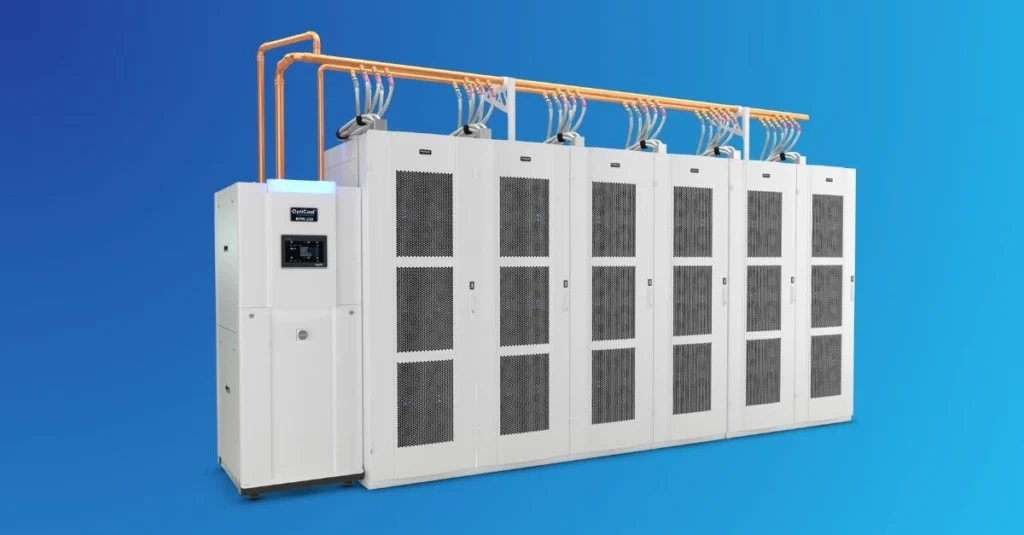The Rise of RDHx in High-Density Data Centers
As the heat density of racks in high density data centers continues to rise rapidly, Rear-Door Heat Exchanger (RDHx) cooling systems have emerged as a highly effective alternative to traditional Computer Room Air Conditioning (CRAC) systems. A Rear-Door Heat Exchanger (RDHx) is a liquid-based cooling system mounted on the back of a server rack that extracts heat directly at the source. OptiCool’s two-phase liquid cooling for data centers efficiently extracts heat from the rack entirely and redistributes it at a controlled temperature. RDHx systems offer superior heat removal capabilities, making them a compelling choice for modern energy-efficient cooling technologies in data centers.
The Problem: Lack of Uniform Rating Criteria
However, due to the fast-paced evolution of data center cooling technologies and efficiency standards, standardized rating criteria for RDHx systems—which typically include fans, heat exchangers, and controllers—are not yet fully established. Consequently, manufacturers often report cooling capacities based on varying and sometimes arbitrary operating conditions. This lack of uniformity makes it difficult for data center managers to perform fair and accurate comparisons between products and evaluate RDHx cooling efficiency.
Table 1. Operating conditions for published RDHx Cooling Capacities.
| Manufacturer 1 | Manufacturer 2 | Manufacturer 3 | |
| Published Cooling Capacity, kW | 78 | 50 | 55 |
| Supply Liquid Temperature, °F | 57.2 | 53.6 | 55-65 |
| Air Temperature at RDHx exit, °F | 75.2 | 69.8 | 75 |
| Air Temperature at RDHx inlet or Server Outlet, °F | Not Available | Not Available | Not Available |
Notably, none of the manufacturers provide the RDHx inlet temperature—a critical parameter that significantly influences RDHx performance. Without this data, the published cooling capacities do not accurately reflect the systems’ true capabilities.
Recommendations for Objective Comparison and Evaluation
To enable meaningful comparisons across RDHx systems, it is recommended to use standardized operating conditions, including:
- Air temperature exiting the servers
- Air temperature exiting the RDHx
- Liquid supply temperature entering the RDHx
These conditions should align with the server exhaust air temperatures outlined in ASHRAE Standard 127. Additionally, the RDHx exit air temperature should fall within the recommended range specified in the ASHRAE TC9.9 Datacom Equipment Thermal Guidelines.
Once standardized conditions are established, cooling capacity should be determined using both the air-side and liquid-side enthalpy methods. According to ASHRAE 127, the results from both methods should agree within 5% to ensure accuracy.
Measuring Energy Efficiency
Beyond cooling capacity, energy efficiency is a key metric for RDHx system evaluation. This can be expressed as the cooling capacity-to-power input ratio, calculated as:
Cooling Capacity ÷ Total Power Input
- Cooling Capacity: Determined using the enthalpy methods described above.
- Total Power Input: Includes power consumed by fans, controllers, and other internal components, measured at the rated voltage and power source.
Note: The fluid pump is typically external to the RDHx system and cannot be measured directly. To assess overall system efficiency, pumping power must be included and can be calculated using the pressure drop across the RDHX:
kWpump = dp x vol ÷ η
Where:
kWpump = Pump power input [kW]
dp = Pressure drop [kPa]
vol = Volumetric flow rate [m3/s]
η = Pump efficiency including motor and impeller efficiencies at the rated voltage and frequency.
This ratio provides a clear measure of energy-efficiency cooling performance. For example, if RDHx System A and System B both deliver 30 kW of cooling, but System A consumes 0.4 kW and System B consumes 0.5 kW, System A has a higher efficiency and would contribute to a lower Power Usage Effectiveness (PUE).
OptiCool RDHx systems – powered by two-phase liquid cooling for data centers – are specifically engineered to minimize power consumption and maximize the cooling capacity-to-power input ratio, thereby enhancing overall energy efficiency in high-density environments.
What’s Next: Industry Standardization Efforts
Organizations such as ASHRAE and AHRI (Air Conditioning, Heating and Refrigeration Institute) are actively working to update and expand standards to accommodate the rapid advancements in RDHX technologies. It is anticipated that standards for rating tests will be established soon for RDHX systems, including both water- and refrigerant-based systems.
Until these standards are finalized, data center managers and operators must take additional steps—such as requesting detailed operating conditions and performing standardized evaluations—to ensure they select RDHX systems that meet their cooling and efficiency requirements.
As RDHx technology continues to advance, energy-efficient high-density data center cooling will play a key role in shaping next-generation standards for sustainable, low-PUE digital infrastructure.
